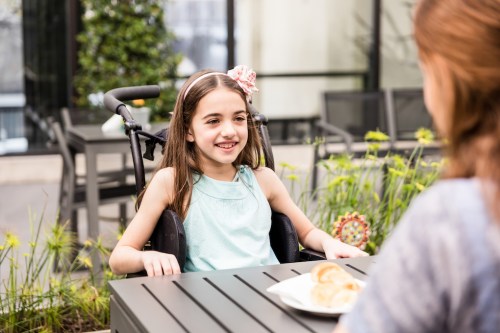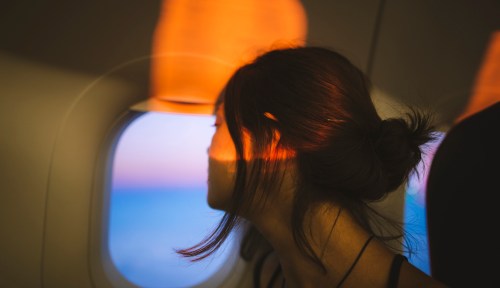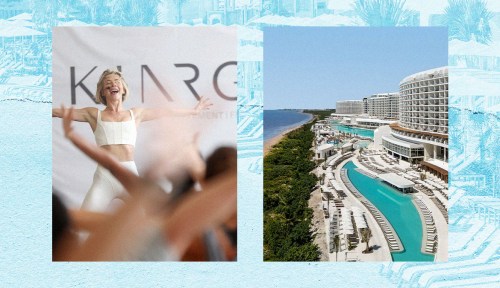Earlier this summer, Airbnb launched a program called “Live Anywhere with Airbnb,” which called for applicants of all backgrounds from around the world to apply for a year of subsidized living in the company’s properties. (What a dream!) In all, 314,000 wannabe nomads applied, and 12 were accepted. One of them, Lindsey Miller-Voss, will be traveling with her mother, Bev, and her daughter Anna, who is 14 and a wheelchair user. Miller-Voss and her family hope to show travelers not only the accessibility issues they face on the road, but also—and more importantly, in their opinions—just how much wheelchair users can do while traveling.
“We love having the opportunity to share Anna’s adventures with folks, and show people that just because a family has somebody in it with a medical diagnosis, or who may have a physical need, you can still go out and explore and do all sorts of great things,” says Miller-Voss. “Our family motto is, ‘We make it work.'”
Anna was adopted from Russia when she was 3.5 years old. She has a genetic condition known as Osteogenesis Imprefecta, Type III, which means her bones break easily. Miller-Voss was undaunted by Anna’s situation, and says she never really saw her condition as a hindrance, thanks to interactions with other families whose kids (a little older than Anna) were dealing with the same challenge. “It was so powerful to me to see them living full and vibrant lives,” she says.
Now, she and her family hope that they will likewise inspire by example; Miller-Voss says Anna has “a really awesome life.” She’s homeschooled, but instead of relying solely on textbooks to teach, the family relies heavily on experiences. So, they spend a lot of time visiting museums, attending concerts, taking science classes at places like the National Zoo and the National Aquarium, and engaging in other sorts of interactive experiences in the Washington D.C. area where they live.
As such, school will look much the same for Anna during her year with Airbnb—only the “classrooms” will change with each new location. The family plans to travel across the country, and are framing their adventure as a “great American road trip.”
“It’s an amazing opportunity to show other people that just because you’re in a wheelchair, you can still have this really cool life,” Anna says. “I think a lot of people tend to forget that, especially since we don’t really see a lot of people in wheelchairs leading cool lives in movies or books or TV or anything like that. It’s important to change perspectives on that.”
Of course, there are challenges, and the family does hope to illuminate some of them while on this journey. Accessible accommodations are tricky to find, for starters. “It’s always a challenge but to be honest, our home is multi-story, and has stairs and isn’t wheelchair accessible, so it’s understandable that not every home out there in the world is accessible,” says Miller-Voss. Still, Airbnb is hoping they can gain insight from Anna’s experiences that may help them to make their platform—and the homes it hosts—more friendly to wheelchair users in the future.
Access while traveling can be limited in other spaces, too. Oftentimes, museum exhibits are hard to see if you’re in a wheelchair, as they are usually designed to be viewed by standing adults.Miller-Voss also says that even though it’s never happened to them, it’s very common for airlines to break wheelchairs in transit. She explains that most full-time wheelchair users do not use the foldable chairs the airplane cabin can accommodate, so wheelchairs are stored in cargo. Imagine, she says, if you landed at your destination to find that the wheelchair you rely upon to get around in was broken in transit—this happens all the time. Airlines in the United States have lost or damaged over 15,000 wheelchairs (approximately 29 per day) since they started reporting findings in late 2018. And these chairs aren’t cheap to replace, either; Anna’s is custom-made for her. “We joke that she can have a new wheelchair, or she can have a car,” says Miller-Voss.
For Anna, one of the most frustrating aspects of traveling as a wheelchair user, though, is how other people treat you. Namely, they tend to push your chair without asking if you need that type of assistance first. This is a big no, no. “A lot of people just come up and push me, and I understand that they don’t really have an idea of how to approach someone in a wheelchair,” Anna says. “But I think if I can help people understand how to respectfully treat someone in a wheelchair, that will make traveling even easier [for wheelchair users].”
The pandemic, of course, has added additional challenges into the mix for Anna and her family, too. Because of her condition, Anna is at a greater risk of COVID-19 complications, and the family engaged in an incredibly strict quarantine prior to vaccination. They were so locked down, in fact, that adventurous Anna only left the house once the entire year—and it was to go to the dentist. So, the entire family is understandably excited to follow-up pandemic quarantine with a year on the road. They decided to limit their trip to American destinations only due to the virus, however, and are making flexible plans so they can easily pivot if outbreaks worsen in certain areas.
Anna has been documenting her life on Instagram and via her website, and will continue to do so throughout the family’s journey so that people can follow their journey. “Through her website, we started writing reviews of places that we’ve been to in order to give accessibility insight so that families who are traveling with somebody in a wheelchair, or using crutches or with mobility limitations, can use it as a resource,” says Miller-Voss.
Aside from creating a travel guide for other wheelchair users like herself, Anna has one other goal she’d like to achieve on this year-long adventure: “Hopefully people will see that anyone can travel, no matter if they are disabled,” says Anna. “It’s not how you get around, but what you did, when, and if you had fun doing it.”
Oh hi! You look like someone who loves free workouts, discounts for cutting-edge wellness brands, and exclusive Well+Good content. Sign up for Well+, our online community of wellness insiders, and unlock your rewards instantly.
Sign Up for Our Daily Newsletter
Get all the latest in wellness, trends, food, fitness, beauty, and more delivered right to your inbox.
Got it, you've been added to our email list.











